HONDA PILOT 2004 1.G Service Manual
Manufacturer: HONDA, Model Year: 2004, Model line: PILOT, Model: HONDA PILOT 2004 1.GPages: 248, PDF Size: 2.98 MB
Page 41 of 248
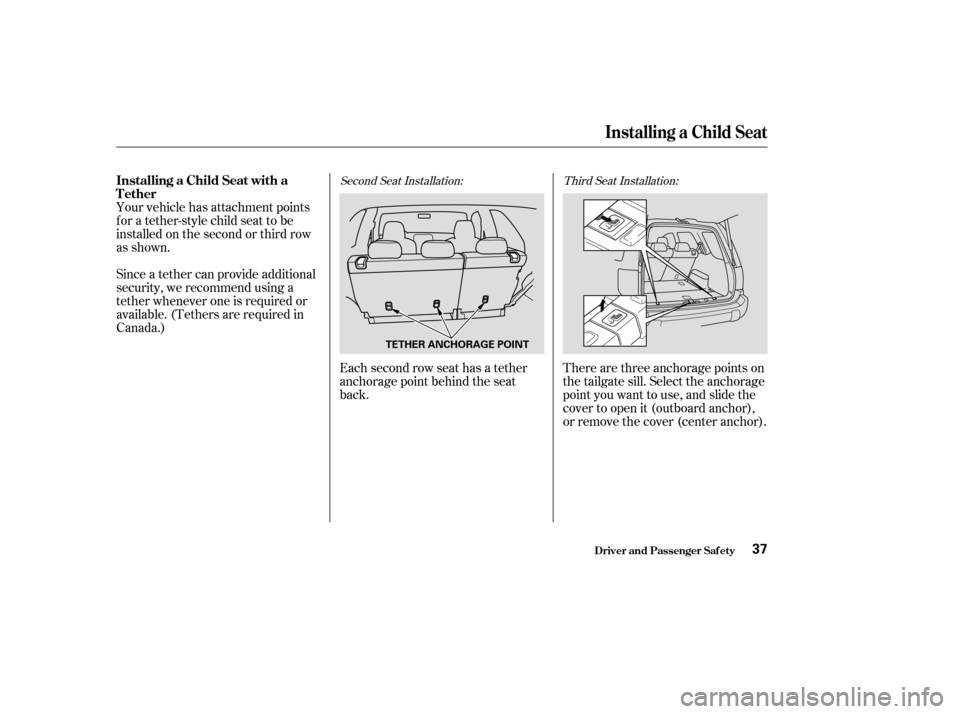
Your vehicle has attachment points
for a tether-style child seat to be
installed on the second or third row
as shown.
Since a tether can provide additional
security, we recommend using a
tether whenever one is required or
available. (Tethers are required in
Canada.)Each second row seat has a tether
anchorage point behind the seat
back.There are three anchorage points on
the tailgate sill. Select the anchorage
point you want to use, and slide the
cover to open it (outboard anchor),
or remove the cover (center anchor).
Second Seat Installation:
Third Seat Installation:
Installing a Child Seat
Driver and Passenger Saf ety
Installing a Child Seat with a
Tether
37
TETHER ANCHORAGE POINT
Page 42 of 248
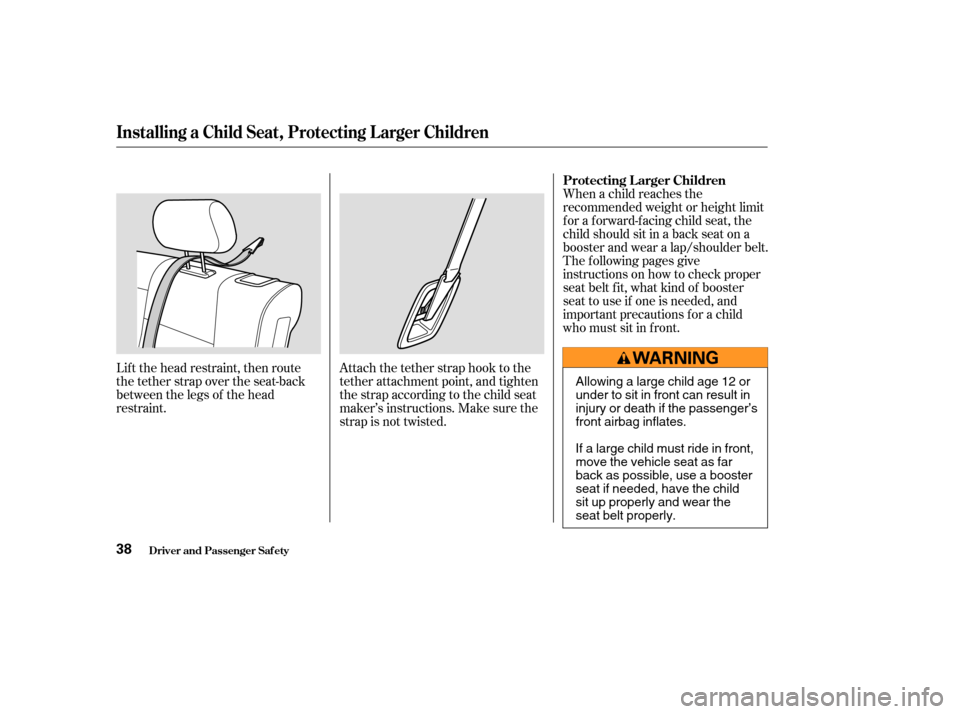
When a child reaches the
recommended weight or height limit
for a forward-facing child seat, the
child should sit in a back seat on a
booster and wear a lap/shoulder belt.
The f ollowing pages give
instructions on how to check proper
seat belt f it, what kind of booster
seat to use if one is needed, and
important precautions f or a child
who must sit in f ront.
Lift the head restraint, then route
the tether strap over the seat-back
between the legs of the head
restraint. Attach the tether strap hook to the
tether attachment point, and tighten
the strap according to the child seat
maker’s instructions. Make sure the
strap is not twisted.
Installing a Child Seat, Protecting L arger Children
Driver and Passenger Saf ety
Protecting L arger Children
38
Allowing a large child age 12 or
under to sit in front can result in
injury or death if the passenger’s
front airbag inflates.
If a large child must ride in front,
move the vehicle seat as far
back as possible, use a booster
seat if needed, have the child
sit up properly and wear the
seat belt properly.
Page 43 of 248
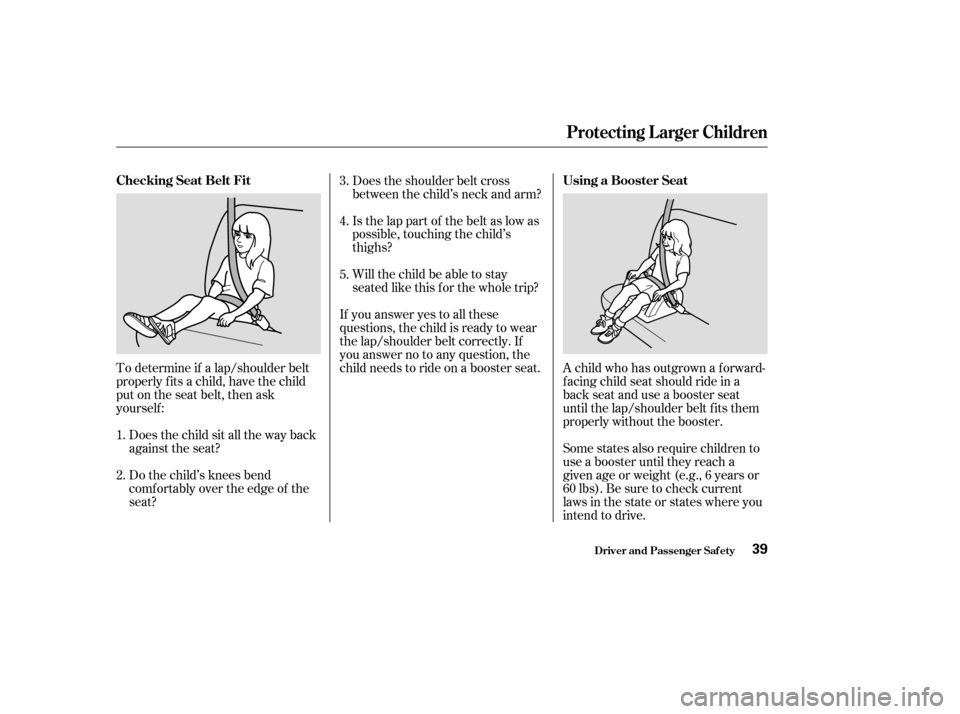
To determine if a lap/shoulder belt
properly f its a child, have the child
put on the seat belt, then ask
yourself :Does the child sit all the way back
against the seat?
Do the child’s knees bend
comf ortably over the edge of the
seat? Does the shoulder belt cross
between the child’s neck and arm?
Is the lap part of the belt as low as
possible, touching the child’s
thighs?
Will the child be able to stay
seated like this f or the whole trip?
If you answer yes to all these
questions, the child is ready to wear
the lap/shoulder belt correctly. If
you answer no to any question, the
child needs to ride on a booster seat. A child who has outgrown a f orward- f acing child seat should ride in a
back seat and use a booster seat
until the lap/shoulder belt f its them
properly without the booster.
Some states also require children to
use a booster until they reach a
given age or weight (e.g., 6 years or
60lbs).Besuretocheckcurrent
laws in the state or states where you
intend to drive.
1.
2. 3.
4.
5.
Protecting L arger Children
Driver and Passenger Saf ety
Checking Seat Belt Fit
Using a Booster Seat
39
Page 44 of 248
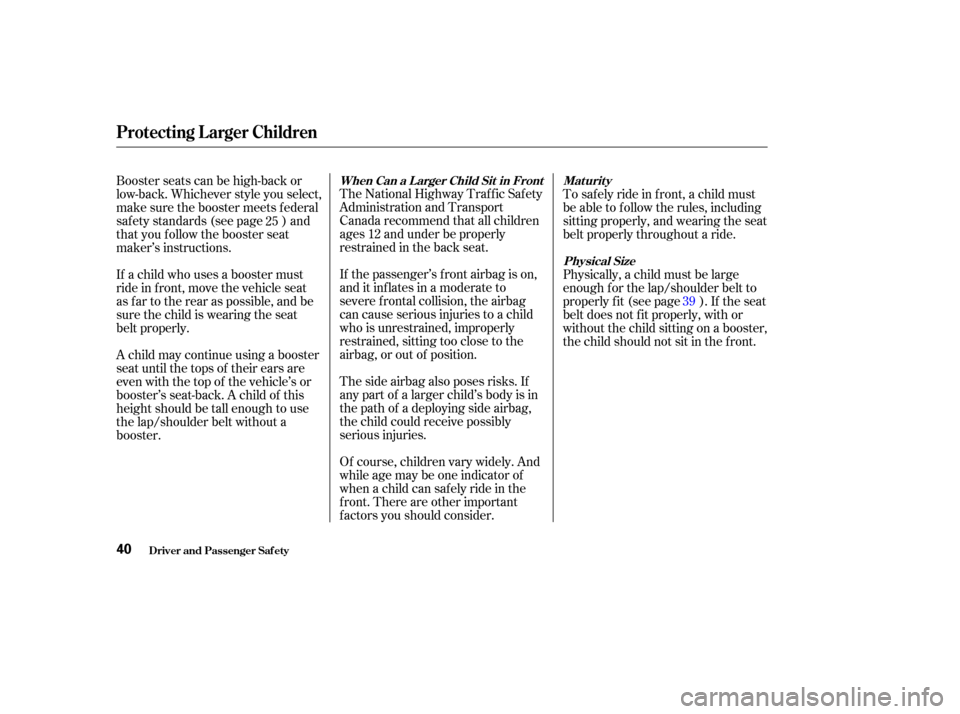
The National Highway Traffic Safety
Administration and Transport
Canada recommend that all children
ages 12 and under be properly
restrained in the back seat.
If the passenger’s f ront airbag is on,
and it inflates in a moderate to
severe f rontal collision, the airbag
can cause serious injuries to a child
who is unrestrained, improperly
restrained, sitting too close to the
airbag, or out of position.
The side airbag also poses risks. If
any part of a larger child’s body is in
the path of a deploying side airbag,
the child could receive possibly
serious injuries.
Of course, children vary widely. And
while age may be one indicator of
when a child can saf ely ride in the
f ront. There are other important
f actors you should consider.To saf ely ride in f ront, a child must
be able to f ollow the rules, including
sitting properly, and wearing the seat
belt properly throughout a ride.
Physically, a child must be large
enough f or the lap/shoulder belt to
properly f it (see page ). If the seat
belt does not f it properly, with or
without the child sitting on a booster,
the child should not sit in the f ront.
Booster seats can be high-back or
low-back. Whichever style you select,
make sure the booster meets f ederal
saf ety standards (see page ) and
that you f ollow the booster seat
maker’s instructions.
If a child who uses a booster must
ride in f ront, move the vehicle seat
as far to the rear as possible, and be
sure the child is wearing the seat
belt properly.
A child may continue using a booster
seat until the tops of their ears are
even with the top of the vehicle’s or
booster’s seat-back. A child of this
height should be tall enough to use
the lap/shoulder belt without a
booster.
39
25
Protecting L arger Children
Driver and Passenger Saf ety
When Can a Larger Child Sit in Front Maturity
Physical Size
40
Page 45 of 248

If you decide that a child can saf ely
ride up f ront, be sure to:Caref ully read the owner’s manual
and make sure you understand all
seat belt instructions and all saf ety
inf ormation.
Move the vehicle seat to the rear-
most position.
Have the child sit up straight, back
against the seat, and feet on or
near the f loor.
Check that the child’s seat belt is
properly positioned and secured.
Supervise the child. Even mature
children sometimes need to be
reminded to f asten the seat belts
or sit properly. This could result in
serious neck injuries during a crash.
This could cause
very serious injuries during a crash.
It also increases the chance that the
child will slide under the belt in a
crash and be injured.
If they do, they could
be very seriously injured in a crash.
Devices intended to improve a
child’s comf ort or reposition the
shoulder part of a seat belt can make
the belt less ef f ective, and increase
the chance of serious injury in a
crash.
Protecting L arger Children
Driver and Passenger Saf ety
Do not let a child wear a seat belt
across t he neck.
Do not let a child put the shoulderpart of a seat belt behind t he back orunder t he arm.
T wo children should never use t hesame seat belt .
Do not put any accessories on a seatbelt.
Additional Saf ety Precautions
41
Page 46 of 248
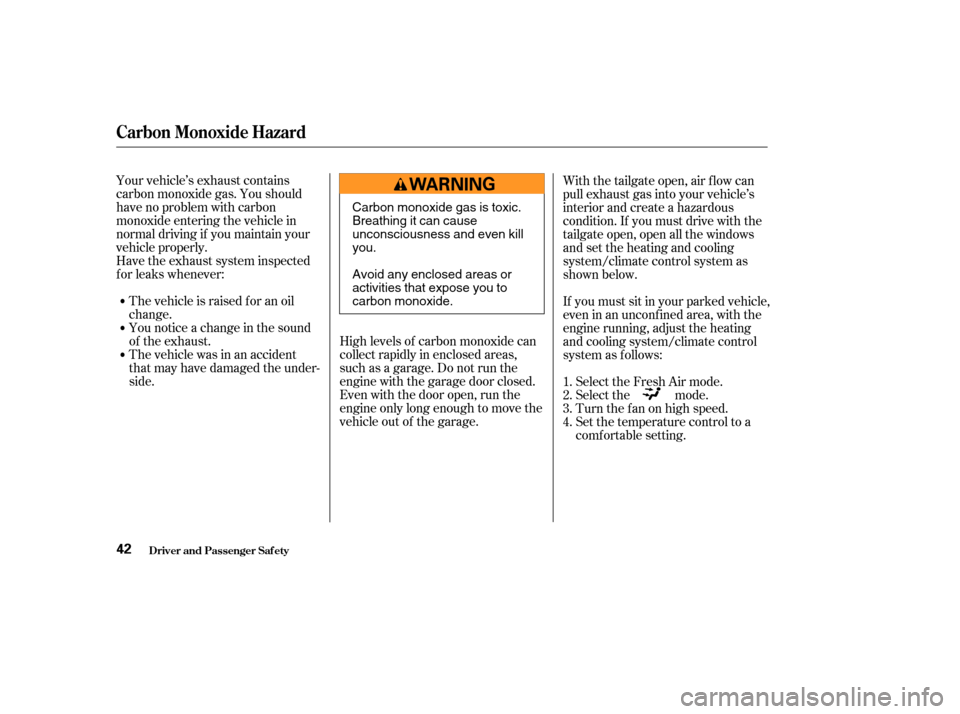
Your vehicle’s exhaust contains
carbon monoxide gas. You should
have no problem with carbon
monoxide entering the vehicle in
normal driving if you maintain your
vehicle properly.High levels of carbon monoxide can
collect rapidly in enclosed areas,
such as a garage. Do not run the
engine with the garage door closed.
Even with the door open, run the
engine only long enough to move the
vehicle out of the garage.
Have the exhaust system inspected
f or leaks whenever:
The vehicle is raised f or an oil
change.
You notice a change in the sound
of the exhaust.
The vehicle was in an accident
that may have damaged the under-
side. With the tailgate open, air flow can
pull exhaust gas into your vehicle’s
interior and create a hazardous
condition. If you must drive with the
tailgate open, open all the windows
and set the heating and cooling
system/climate control system as
shown below.
If you must sit in your parked vehicle,
even in an unconf ined area, with the
engine running, adjust the heating
and cooling system/climate control
system as f ollows:
Select the Fresh Air mode.
Select the mode.
Turn the f an on high speed.
Set the temperature control to a
comfortable setting.
1.
2.
3.
4.
Carbon Monoxide Hazard
Driver and Passenger Saf ety42
Carbon monoxide gas is toxic.
Breathing it can cause
unconsciousness and even kill
you.
Avoid any enclosed areas or
activities that expose you to
carbon monoxide.
Page 47 of 248
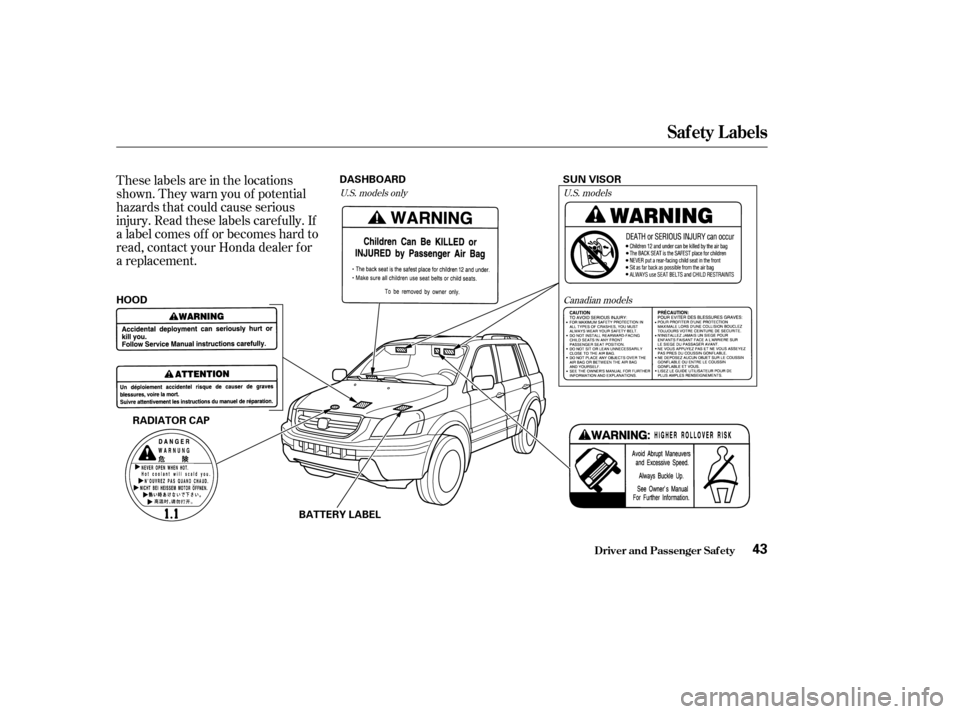
These labels are in the locations
shown. They warn you of potential
hazards that could cause serious
injury. Read these labels caref ully. If
a label comes of f or becomes hard to
read, contact your Honda dealer f or
a replacement.U.S. models onlyU.S. models
Canadian models
Saf ety L abels
Driver and Passenger Saf ety43
RADIATOR CAP SUN VISOR
HOOD DASHBOARD
BATTERY LABEL
Page 48 of 248

44
Page 49 of 248

This section gives inf ormation about
the controls and displays that
contribute to the daily operation of
your Honda. All the essential
controls are within easy reach............................
Control Locations .46
............................
Instrument Panel .47
.............................................
Gauges .54
...............
Odometer/Trip Meter . 54
..................................
Fuel Gauge .54
...................
Temperature Gauge . 55
....
Outside Temperature Gauge . 55
Controls Near the Steering ...........................................
Wheel .56
.
Windshield Wipers and Washers . 57
...........
Turn Signal and Headlights . 58
........
Instrument Panel Brightness . 59
.................
Hazard Warning Button . 59
.................
Rear Window Def ogger . 60
..........
Steering Wheel Adjustment . 61
...............................
Keys and Locks .62
........................
Immobilizer System .62
................................
Ignition Switch .64
......................................
Door Locks .65
......................
Power Door Locks .65
..............
Childproof Door Locks . 65
.......................
Remote Transmitter .66
..................................
Seats Heaters .67
.................................................
Seats .68
..............................
Power Windows .73
.............................................
Mirrors .74 .................................
Parking Brake .75
...........
Interior Convenience Items . 76
.......................
Beverage Holders .77
...............
Console Compartment . 77
......................
Sunglasses Holder .78
....................................
Glove Box .78
......................................
Sun Visor .78
...............................................
Lights .79
Instruments and Controls
Inst rument s and Cont rols45
Page 50 of 248
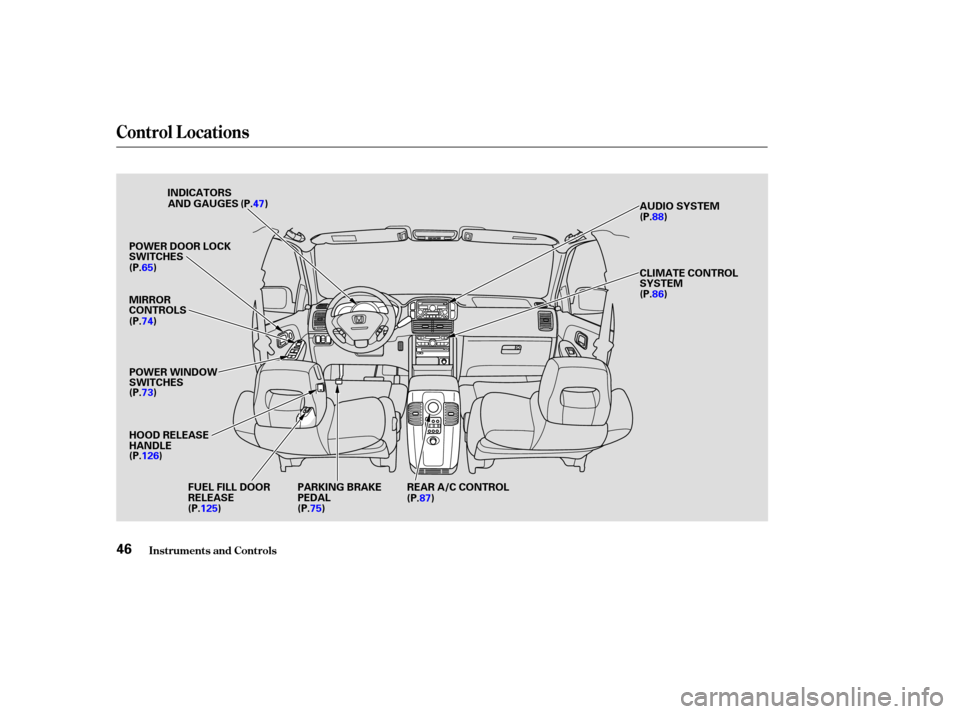
Control L ocations
Inst rument s and Cont rols46
POWER DOOR LOCK
SWITCHES
MIRROR
CONTROLSPOWER WINDOW
SWITCHES
HOOD RELEASE
HANDLE AUDIO SYSTEM
CLIMATE CONTROL
SYSTEM
FUEL FILL DOOR
RELEASE PARKING BRAKE
PEDAL REAR A/C CONTROL
AND GAUGES (P.
47)
INDICATORS
(P.65)
(P.74)
(P.73)
(P.126) (P.125) (P.75)(P.87) (P.86) (P.88)